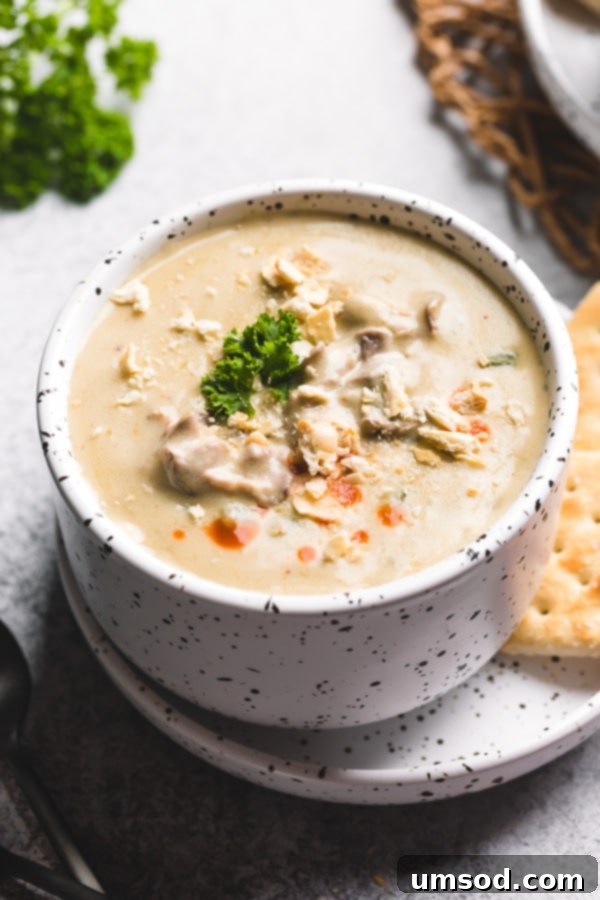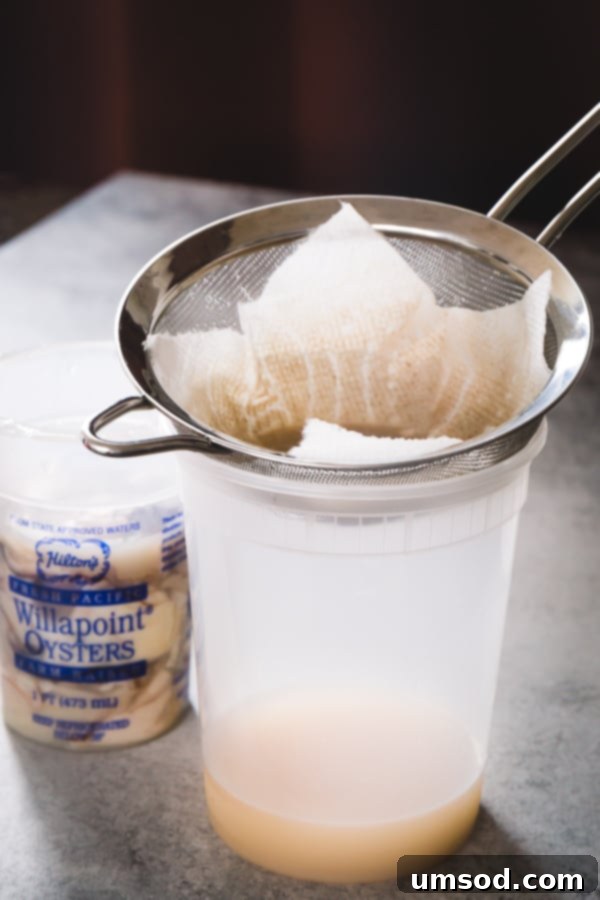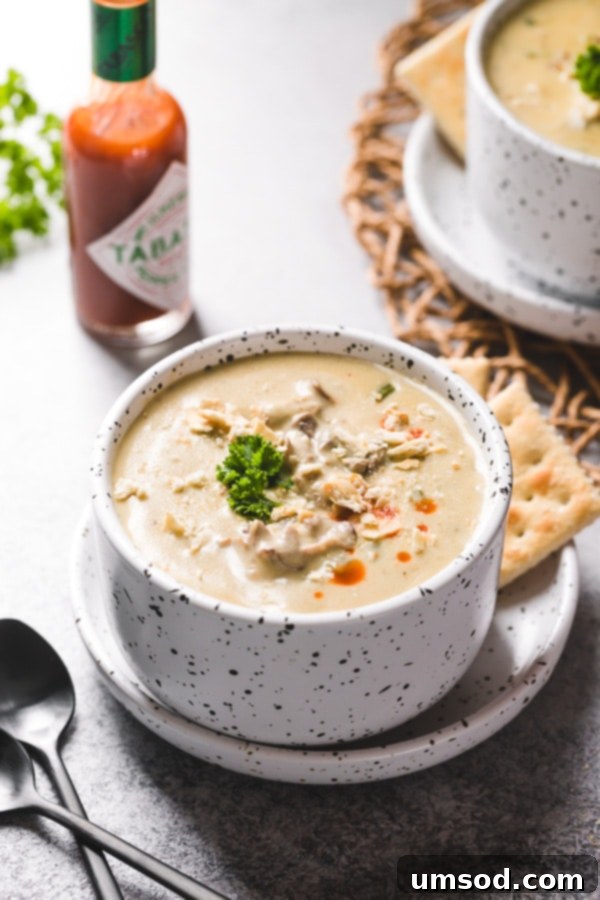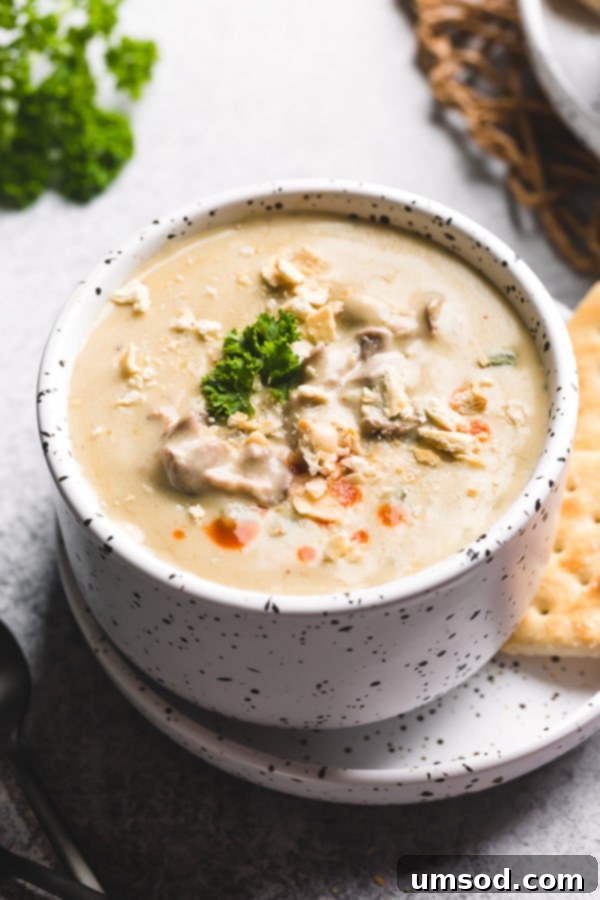Don’t be fooled by its comforting simplicity; this family-favorite oyster stew is truly an unforgettable culinary experience! What sets our recipe apart from many traditional versions is the subtle yet impactful addition of potatoes. This clever touch makes the stew incredibly satisfying and hearty, ensuring it “sticks to your ribs” without ever overpowering the delicate, briny flavor of the fresh oysters. Prepare to discover a new favorite that will warm your soul and delight your taste buds.

The Ultimate Creamy Oyster Stew: A Heartwarming Family Tradition
While oyster stew has long been a quintessential dish gracing Christmas Eve tables, its rich flavor and comforting nature make it far too delicious to reserve for just one holiday. This recipe invites you to enjoy its exquisite taste year-round, whether you live by the ocean or, like me, rely on high-quality jarred oysters to bring the taste of the sea to your kitchen. Our rendition offers a perfect balance of creamy texture, subtle seasoning, and that unmistakable delicate oyster essence, ensuring every spoonful is a delight.
Why Our Oyster Stew Stands Out: A Cozy Classic for Any Occasion
Oyster stew holds a special place in culinary history, particularly as a cherished tradition during the festive season. Its origins are often tied to coastal communities where oysters were abundant and provided a luxurious yet accessible ingredient for celebratory meals. Over time, it evolved into a beloved dish for many, symbolizing warmth and gathering. Our recipe embraces this heritage while adding a unique twist that elevates it beyond the ordinary. The inclusion of a small amount of potato isn’t just about making the stew more filling; it subtly enhances the texture, providing a creamy body that beautifully cradles the oysters without competing with their natural flavor. This thoughtful addition makes our stew more robust and satisfying, perfect for a chilly evening or a celebratory gathering.
Key Ingredients for an Unforgettable Oyster Stew
Creating an exceptional oyster stew begins with selecting the right ingredients. Each component plays a vital role in achieving that perfect balance of richness, flavor, and creamy texture.
- Oysters: The Star of the Show
Your choice of oysters can significantly impact the final dish. While freshly shucked oysters offer an unparalleled ocean-fresh flavor, they aren’t always readily available. For those living inland, high-quality jarred oysters are a fantastic alternative. They offer convenience without compromising on taste, especially when you utilize their nutrient-rich liquid. This recipe is designed to shine with either option, ensuring a delicious outcome.
- Fat: The Foundation of Flavor
For an extra layer of savory depth, I highly recommend using bacon fat to sauté your vegetables. The smoky undertones beautifully complement the oysters. If bacon fat isn’t available or preferred, unsalted butter is an excellent choice, lending a rich, classic flavor. For a lighter touch, a good quality olive oil can also be used, though it will result in a slightly different flavor profile.
- Potatoes: The Secret to Satisfaction
Unlike many traditional oyster stew recipes, ours features a smallish potato, which is key to its hearty, “stick-to-your-ribs” quality. Russet potatoes, known for their starchiness, and Yukon Gold potatoes, praised for their creamy texture, are both ideal choices. They break down slightly during cooking, contributing to the stew’s luscious consistency without diluting the delicate oyster taste.
- Milk: For Creamy Indulgence
Whole milk is strongly recommended for this recipe. Its higher fat content contributes significantly to the stew’s rich, luxurious, and truly comforting texture. While other dairy options like half-and-half or evaporated milk can be used, whole milk delivers the most authentic and decadent flavor that truly defines this family favorite.
- Aromatics & Seasoning: Building Depth
Diced celery and minced shallots provide a subtle aromatic base, enhancing the overall flavor without overpowering the delicate oysters. A modest amount of all-purpose flour helps create a light roux, thickening the stew to perfection. Old Bay seasoning adds a classic touch of seafood flavor, while salt balances the savory notes. Remember, the goal is to let the oysters shine, so seasoning is kept judiciously balanced.
Choosing Your Oysters: Fresh vs. Jarred for Perfect Stew
The success of your oyster stew hinges significantly on the quality of the oysters you choose. Both fresh and jarred oysters can yield excellent results, each with its own advantages. Understanding how to select them ensures the best possible flavor and texture for your stew.
Freshly Shucked Oysters: If you have access to fresh oysters and are comfortable shucking them, they will undoubtedly provide the most vibrant, briny taste. Look for oysters that are tightly closed, indicating freshness. Once shucked, they should smell clean and oceanic, not fishy. The natural liquor within fresh oysters is incredibly flavorful and should be carefully reserved and strained for your stew.
Jarred Oysters: Convenience and Quality: For most home cooks, jarred oysters are a convenient and excellent choice. They are already shucked and preserved in their own liquor, making preparation quick and easy. When purchasing jarred oysters, always look for them in clear glass jars or transparent plastic tubs. This allows you to visually inspect the product before buying.
Here’s what to look for when choosing jarred oysters:
- Clear Liquid: The liquid the oysters are packed in should be clear and clean. Avoid any jars with cloudy or murky liquid, as this can indicate spoilage or poor quality.
- Plumpness and Color: The oysters themselves should appear plump and firm, with a fresh, natural color. They shouldn’t look shriveled or discolored.
- Use the Liquor: One significant advantage of jarred oysters is that their preserving liquid often contains more nutrients and flavor than the liquid from freshly shucked oysters, especially after transport. This recipe explicitly uses all the liquid from the jar, ensuring no flavor or nutritional value is wasted and contributes to the stew’s depth.

Crafting Your Perfect Oyster Stew: Step-by-Step Guide
Making this oyster stew is surprisingly simple, focusing on gentle cooking and highlighting the natural flavors of the oysters. The key is to avoid over-seasoning, allowing the delicate mineral taste of the oysters to truly shine.
- Oyster Preparation: Carefully drain the oysters over a bowl, using a fine-mesh sieve lined with a paper towel or cheesecloth. This step is crucial for catching any potential sand or shell fragments. Rinse the oysters gently under cold water, then roughly chop them if desired for a more uniform texture in the stew. Be sure to reserve all the strained oyster juice, as it’s a powerhouse of flavor for your base.
- Sautéing the Aromatics: In a large pot or Dutch oven, heat your chosen fat—bacon fat for a smoky richness or butter for classic creaminess—over medium-high heat. Once melted and shimmering, add the diced potatoes, celery, and minced shallot. Sauté these vegetables for about 2-3 minutes, stirring frequently until they begin to soften and become fragrant. The gentle sautéing process helps build the foundational flavors of the stew.
- Building the Roux: Reduce the heat to medium. Add the all-purpose flour, Old Bay seasoning, and salt to the pot. Cook this mixture, stirring constantly, for about 1 minute. This creates a light roux, which thickens the stew beautifully and eliminates any raw flour taste. The flour should achieve a slightly nutty aroma, indicating it’s properly toasted.
- Incorporating Oyster Liquor: Gradually pour the reserved, strained oyster juice into the pot, stirring continuously. As you stir, make sure to scrape any “fond” (the delicious browned bits) from the bottom of the pan. The mixture will thicken considerably at this stage, which is perfectly normal. If it becomes too thick to stir easily, add a tablespoon or two of water to help deglaze and incorporate all those flavorful bits.
- Adding Warmed Milk: Slowly pour the slightly warmed whole milk into the pot, stirring constantly. This gradual incorporation is vital for achieving a smooth, velvety texture and preventing curdling. Warming the milk beforehand is a simple but effective trick that serves two important purposes:
- To prevent curdling: Introducing cold milk to a hot base can shock the dairy and cause it to curdle. Warming it first minimizes this temperature difference.
- To cut down cooking time: Pre-warmed milk helps the stew come to a gentle simmer more quickly and evenly.
- Gentle Simmering: Reduce the heat to low or simmer. Slowly bring the soup to a gentle simmer, allowing the potatoes to cook until tender, which typically takes about 15 minutes. This step requires patience; rushing it by bringing the soup to a rapid boil too quickly is a common cause of curdling. The stew should never boil vigorously at any point.
- The Final Oyster Infusion: Once the potatoes are tender and the stew is perfectly creamy, add the chopped oysters. Cook for just 2-3 minutes more. Oysters cook very quickly, and overcooking them will make them tough and rubbery. This brief cooking time ensures they remain tender and succulent.
- Serve Immediately: Ladle the steaming hot stew into bowls and serve immediately. Garnish with fresh parsley, a dash of your favorite hot sauce, and a side of soda crackers for a truly satisfying meal.

Troubleshooting: Ensuring a Smooth, Curdle-Free Oyster Stew
Achieving a perfectly smooth, creamy oyster stew is the goal, as a curdled stew, while still tasting good, can be visually unappetizing. Fortunately, understanding the causes of curdling allows you to take simple preventative measures.
What Causes Curdling?
The primary culprit behind curdled oyster stew is heat. Specifically, exposing dairy to excessive heat, or rapid changes in temperature, can cause the milk proteins to coagulate and separate. This is why dairy-based soups and stews often curdle if brought to a rolling boil or if cold milk is added directly to a hot base.
Key Preventative Measures:
- Slow and Gentle Heating: The most crucial step is to heat your oyster stew slowly and gently. Your stew should never reach a vigorous boil at any stage of the cooking process. Maintain a low simmer throughout, allowing the flavors to meld and the potatoes to cook without shocking the milk.
- Warm the Milk: Adding cold milk to a warmer stew creates a significant temperature differential that can instantly cause curdling. To avoid this, always warm your milk slightly before incorporating it into the stew. A quick minute or two in the microwave, or gently heating it in a separate saucepan until it’s lukewarm, is sufficient.
- Stir Continuously: When adding both the oyster liquor and the warmed milk, stir constantly. This ensures even heat distribution and helps the liquids integrate smoothly into the base without clumping or separating.
What If Your Stew Starts to Curdle? (The Rescue Mission)
If you notice your oyster stew beginning to curdle, act quickly to try and salvage it:
- Immediately Remove from Heat: Take the pot off the stove right away to stop the cooking process and prevent further curdling.
- Add Cold Milk: Slowly drizzle in a small amount (about 1/4 to 1/2 cup) of cold milk, stirring continuously. The sudden introduction of cold liquid can help stabilize the temperature and bring the separated proteins back together.
- Reheat Gently: Once the temperature of the stew appears to have stabilized and the texture has improved, return the pot to very low heat and slowly bring it back to a gentle simmer, stirring frequently. There’s no absolute guarantee the stew won’t curdle again, but following these steps significantly increases your chances of recovery.
Bonus Tip: Evaporated Milk
For those particularly concerned about curdling, using evaporated milk instead of fresh whole milk can offer an extra layer of protection. Evaporated milk is heat-treated and more stable, making it less prone to curdling under heat. While it imparts a slightly different flavor profile, it’s a reliable option for a smoother stew.

Serving and Enjoying Your Homemade Oyster Stew
Oyster stew is truly at its best when served immediately, allowing you to savor its warmth, delicate flavors, and creamy texture precisely as intended. After all the care taken to achieve that perfect consistency, you’ll want to enjoy it fresh from the pot!
Garnish and Accompaniments:
- Fresh Herbs: A sprinkle of freshly chopped parsley or chives adds a touch of color and a burst of fresh flavor that complements the richness of the stew beautifully.
- A Hint of Heat: For those who enjoy a little kick, a dash of hot sauce (like Tabasco or a similar cayenne-based sauce) can awaken the flavors and add an exciting dimension. Serve it on the side so each diner can customize their bowl.
- Classic Crackers: Soda crackers are a traditional and beloved accompaniment to oyster stew. Their crisp, slightly salty texture provides a wonderful contrast to the creamy soup.
- Crusty Bread: A warm, crusty baguette or a slice of artisan bread is perfect for soaking up every last drop of the delicious broth.
Complementary Side Dishes:
When selecting side dishes, aim for simple flavors that will enhance, rather than compete with, the delicate richness of the stew.
- Simple Green Salad: A light, crisp green salad with a vinaigrette dressing can offer a refreshing counterpoint to the creamy stew.
- Roasted Vegetables: Gently roasted asparagus, green beans, or even a medley of root vegetables can provide a nice texture and earthy flavor without being too heavy.
- Baked or Roast Potatoes: While the stew contains potatoes, a small side of simply baked or roasted potatoes can add another layer of comforting texture if desired.
Storage and Reheating Tips for Oyster Stew
While best enjoyed fresh, you can certainly store and reheat leftover oyster stew with care. Proper handling ensures you maintain its delicious flavor and creamy texture.
Can I Freeze Oyster Stew?
Yes, oyster stew can be frozen, though dairy-based soups sometimes undergo a slight texture change upon thawing and reheating. To minimize this, ensure the stew is completely chilled before freezing. I recommend freezing it in single-serving portions in airtight, freezer-safe containers or bags. This allows for convenient thawing and reheating of just the amount you need.
Frozen oyster stew can be stored for up to 1 month. When ready to enjoy, thaw it overnight in the refrigerator.
How Long is Oyster Stew Good for in the Refrigerator?
Leftover oyster stew should be stored in an airtight container in the refrigerator and consumed within 3 days. Beyond this, the quality of the oysters and dairy can begin to degrade.
Reheating Oyster Stew for Best Results
Reheating oyster stew requires the same gentle approach as cooking it initially to prevent curdling. Always reheat slowly over low heat, stirring frequently. Avoid bringing it to a vigorous boil. If the stew seems too thick after reheating, you can stir in a splash of warm milk or oyster liquor (if you have any extra reserved) to restore its original consistency. Taste and adjust seasonings as needed.

Oyster Stew
Comment
Print Recipe
Ingredients
- 1 pint (473 ml) oysters (Note 1: Use jarred or freshly shucked oysters.)
- 3 tablespoons bacon fat or butter
- 1 cup diced potato (about 1 small potato, Note 2)
- 1 cup diced celery (2-3 celery stalks)
- 1 small shallot, minced
- 3 tablespoons all-purpose flour
- 1 teaspoon Old Bay seasoning
- ½ teaspoon salt (more to taste)
- 2 cups whole milk (slightly warmed, Note 3)
For serving:
- Fresh parsley
- Hot sauce (such as Tabasco)
- Soda crackers
Instructions
- Drain the oysters over a bowl through a sieve, rinsing under cold water to remove any sand or shell bits. Reserve the oyster juice. Roughly chop the oysters.
- Place a paper towel over a mesh sieve to catch any impurities and run the reserved oyster juice through the sieve into a clean bowl.
- Heat a large pot over medium-high heat.
- Add bacon fat or butter.
- Once the fat is melted and hot, add potatoes, celery, and shallot. Cook for 2-3 minutes, stirring frequently.
- Reduce heat to medium and add flour, Old Bay seasoning, and salt. Cook, stirring constantly, until the flour is nicely toasted and smells nutty, about 1 minute.
- Slowly add the reserved oyster juice, continuously stirring everything and scraping the fond (brown bits) built on the bottom of the pan. The mixture will become quite thick, which is normal. If needed, add 1-2 tablespoons of water to help loosen and scrape off all the brown bits.
- Then slowly pour in the warmed milk, while stirring constantly, to gradually incorporate everything and achieve a smooth consistency.
- Reduce heat to low/simmer, and slowly heat the soup up until it reaches a gentle simmer. Continue to simmer until the potatoes are cooked and tender, about 15 minutes. TIP: Do not rush this step. If you bring the soup to a boil too quickly, it may curdle, which will affect its appearance even if the flavor remains good.
- Add the chopped oysters and cook for another 2-3 minutes, just until they are plump and heated through. Avoid overcooking the oysters to keep them tender.
- Serve immediately with fresh parsley, a dash of hot sauce, and soda crackers.
- Store leftover oyster stew in an airtight container in the fridge for up to 3 days, or freeze for up to 1 month. Thaw frozen oyster stew in the fridge overnight, then reheat it slowly over low heat, stirring occasionally.
⭐️ Did you make this recipe?
Please leave a review and let us know how you liked it!
Tips & Notes
Note 1: You can use either jarred oysters (which are convenient) or freshly shucked oysters for this recipe. Both work wonderfully.
Note 2: You’ll need about one small potato. Russet or Yukon Gold potatoes are recommended for their texture and ability to enhance the stew’s creaminess.
Note 3: Whole milk is highly recommended for the richest flavor and creamiest texture. Warming the milk slightly before adding it is crucial to prevent curdling and to help the stew heat evenly.
Nutrition

Frequently Asked Questions About Oyster Stew
What is the difference between Oyster Stew and Oyster Chowder?
While the terms are sometimes used interchangeably, there are typically subtle distinctions. Our oyster stew, for example, is characterized by its thick, creamy consistency, achieved with a light roux and whole milk, often featuring tender pieces of potato. Generally, stews are hearty, thick, and satisfying soups. Chowders, on the other hand, are also thick, creamy soups, often containing more chunky vegetables like potatoes or corn, and are traditionally thickened with a roux and rich cream or milk. The main difference often lies in the specific ingredients and regional preparations, but both offer a comforting, dairy-based seafood experience.
Can I use half-and-half or heavy cream instead of whole milk?
Absolutely! While whole milk provides a beautiful richness, you can certainly use half-and-half for a slightly lighter but still creamy stew. Heavy cream will result in an even more decadent and rich texture. Be aware that heavy cream is less likely to curdle than milk, offering a bit more flexibility with heat, but it will also make the stew significantly richer. Adjusting the amount of flour slightly might be necessary if using different dairy types to maintain your preferred consistency.
What if I don’t have Old Bay seasoning?
Old Bay seasoning offers a classic seafood flavor profile, but if you don’t have it, you can create a similar blend. A good substitute would be a mix of paprika, celery salt, black pepper, and a pinch of cayenne pepper, garlic powder, and onion powder. The key is to add a nuanced, savory warmth without overpowering the oysters. You can also simply use salt and pepper, allowing the natural oyster flavor to be the sole star.
Can I add other vegetables to the stew?
While our recipe focuses on a minimalist approach to let the oysters shine, you can certainly add other vegetables if you wish. Finely diced carrots or a small amount of leeks, added along with the celery and shallots, can lend additional flavor and color. Be mindful not to add too many competing flavors or textures that might detract from the delicate oysters.
How can I make this oyster stew spicier?
For those who enjoy a spicier kick, there are several easy ways to enhance the heat. You can add an extra dash or two of hot sauce when serving, or incorporate a pinch of cayenne pepper into the flour mixture when making the roux. A small amount of finely minced jalapeño or serrano pepper could also be sautéed with the other vegetables for a fresh, vibrant heat, but use sparingly to avoid overwhelming the oysters.
More Hearty Recipes to Warm Your Soul
If you savor comforting, hearty soups and stews, explore these other delightful recipes:
- Dutch Oven Beef Stew
- Instant Pot Chicken Stew
- Instant Pot Beef Stew
- Chunky Beef Chili
Delicious Bread Pairings for Your Stew
Complete your meal with a perfect bread accompaniment:
- Easy French Bread
- Beginner’s Sourdough Bread
